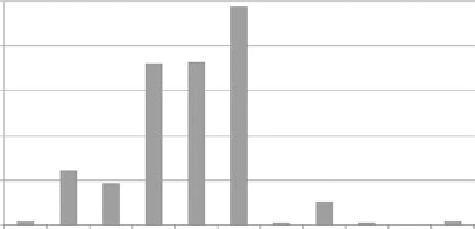Environmental Engineering Reference
In-Depth Information
5.E-05
4.E-05
3.E-05
2.E-05
1.E-05
0.E+00
FIGure 11.34
Land requirements of various electricity sources. (From Spitzley, D.V. and Keoleian, G.A.,
Life Cycle Environmental and Economic Assessment of Willow Biomass Electricity: A Comparison with Other
Renewable and Non-Renewable Sources
, 2005. Available at http://css.snre.umich.edu/main.php?control=
detail_proj&pr_project_id = 19)
land, and Conservation Reserve Program land, whereas natural gas extraction points may be more
constrained.
11.5 overall conclusIons
LCA provides a framework for quantifying the sustainability of products and systems, and the
results can be used to improve system performance. The biofuel and biomass electricity studies
discussed in this chapter used different metrics, allocation methods, system boundaries, and data.
Results are contingent upon these differences. Despite this, the following conclusions can be drawn
from the biofuel studies considered in this chapter:
(1) using corn ethanol rather than gasoline can significantly reduce life-cycle petroleum con-
sumption but only modestly reduce GHG emissions when indirect land-use change is not con-
sidered; (2) sugarcane ethanol production in Brazil requires less fossil fuel inputs and results in
less GHG emissions than corn ethanol, with a primary reason being the use of renewable bagasse
(sugarcane plant residue) to power the conversion facility and displace grid electricity; (3) switch-
grass-derived ethanol can be produced at an estimated ratio of 13.1 MJ ethanol/MJ petroleum and
reduce life-cycle GHG emissions by 94%; and (4) producing and consuming soybean biodiesel
in the United States could reduce life-cycle petroleum use by 95% and CO
2
emissions by 78%
compared with petroleum diesel when land-use change is not considered (Sheehan et al. 1998;
Farrell et al. 2006; Wang et al. 2007; Schmer et al. 2008; Searchinger et al. 2008, respectively).
The recently revised U.S. Renewable Fuel Standard, a component of the EISA 2007, regulates
biofuel production levels in the United States through the year 2022. Life-cycle GHG emissions
reduction criteria are central to the legislation, and indirect land-use change effects were incor-
porated into the final peer-reviewed life-cycle model, which was used to determine qualifying
fuels. U.S. corn ethanol and soybean biodiesel produced in modern, efficient plants qualify under
this program and are projected to be significant components of U.S. biofuel consumption through
2022. Modeling results also show that sugarcane ethanol offers greater GHG reductions than

